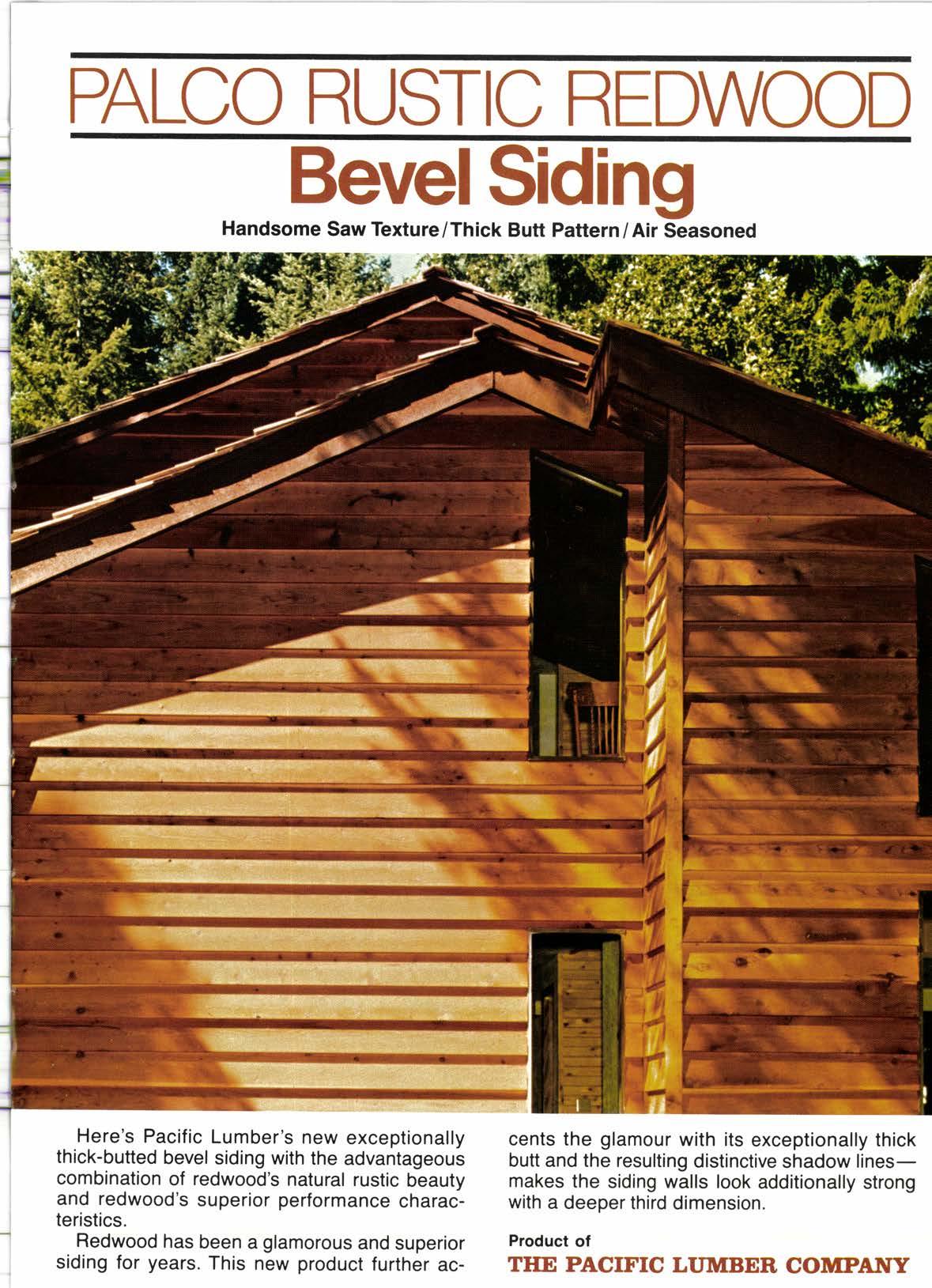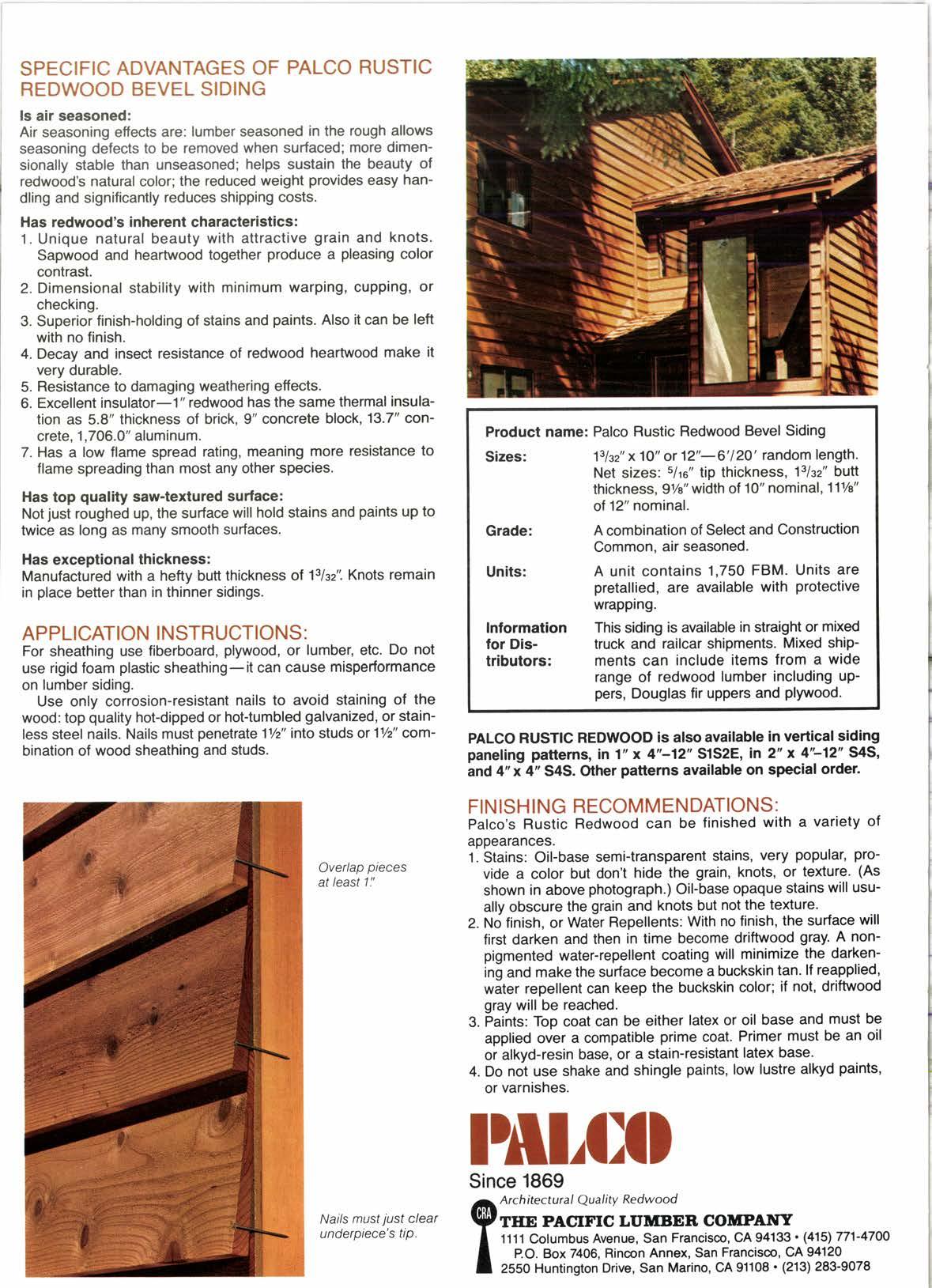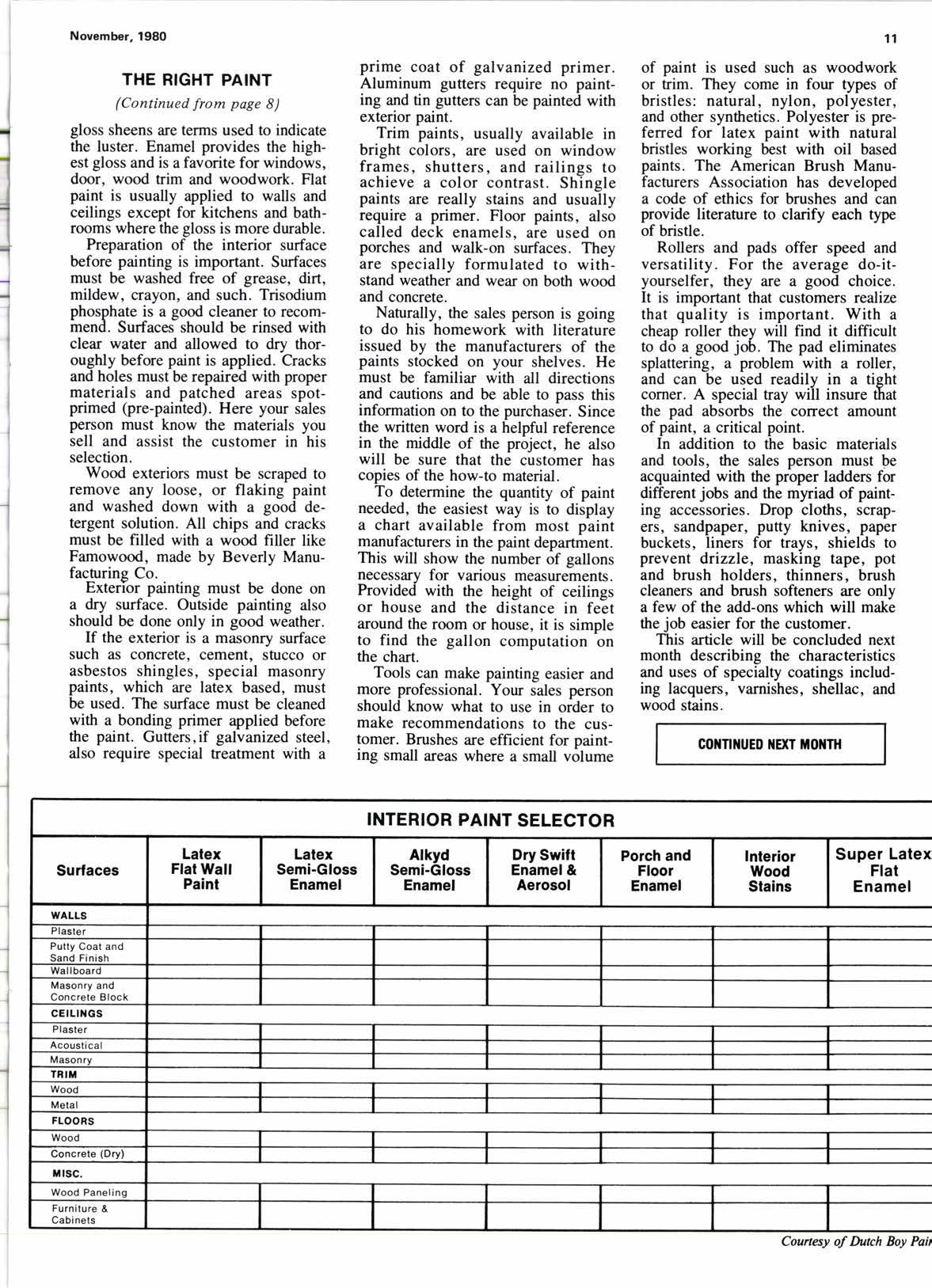
5 minute read
F?ALCO RUSTIC REDWOOD Bevel Siding
Here's Pacific Lumber's new exceptionally thick-butted bevel siding with the advantageous combination of redwood's natural rustic beauty and redwood's superior performance characteristics.
Redwood has been a glamorous and superior siding for years. This new product further ac- cents the glamour with its exceptionally thick butt and the resulting distinctive shadow linesmakes the siding walls look additionally strong with a deeper third dimension.
Product of
Specific Advantages Of Palco Rustic Redwood Bevel Siding

ls air seasoned:
Air seasoning efiects are: lumber seasoned in the rough allows seasoning defects to be removed when surfaced; more dimensionally stable than unseasoned; helps sustain the beauty of redwood's natural color; the reduced weight provides easy handling and significantly reduces shipping costs.
Has redwood's inherent characteristics:
1. Unique natural beauty with attractive grain and knots. Sapwood and heartwood together produce a pleasing color contrast.
2. Dimensional stability with minimum warping, cupping, or checking.
3. Superior finish-holding of stains and paints. Also it can be left with no finish.
4. Decay and insect resistance of redwood heartwood make it very durable.
5. Resistance to damaging weathering effects.
6. Excellent insulator-1" redwood has the same thermal insulation as 5.8" thickness ol brick, 9" concrete block, 13.7" concrete, 1,706.0" aluminum.
7. Has a low flame spread rating, meaning more resistance to flame spreading than most any other species.
Has top quality saw-textured surface: Not just roughed up, the surface will hold stains and paints up to twice as long as many smooth surfaces.
Has exceptional thickness: Manufactured with a hefty butt thickness ol 13lsz". Knots remain in place better than in thinner sidings.
APPLICATION INSTRUCTIONS :
For sheathing use fiberboard, plywood, or lumber, etc. Do not use rigid foam plastic sheathing-it can cause misperformance on lumber siding.
Use only corrosion-resistant nails to avoid staining of the wood: top quality hot-dipped or hot-tumbled galvanized, or stainless steel nails. Nails must penetrate |Vz" inlo studs or 11h" combination of wood sheathing and studs.
Product name: Palco Rustic Redwood Bevel Siding
Sizes: 13lsz" x 10" or 12'-6'120' random length. Net sizes: s/rs" tip thickness, 13/ez" butt thickness, 97g" width of 10" nominal11V8' of 12" nominal.
Grade: A combination of Select and Construction Common, air seasoned.
Units: A unit contains 1,750 FBM. Units are pretallied, are available with protective wrapping.
Information This siding is available in straight or mixed for Dis- truck and railcar shipments. Mixed shiptributors: ments can include items from a wide range of redwood lumber including uppers, Douglas fir uppers and plywood.
PALCO RUSTIC REDWOOD is also available in vertical siding paneling patterns, in 1" x 4"-12'S1S2E, in 2" x 4'L12" S4S, and 4"x 4" S4S. other pattems available on special order.
FIN ISH ING RECOMMENDATIONS:
Palco's Rustic Redwood can be finished with a variety ol appearances.
1. Stains: Oil-base semi-transparent stains, very popular, provide a color but don't hide the grain, knots, or texture. (As shown in above photograph.) OiFbase opaque stains will usually obscure the grain and knots but not the texture.
Z. tto tinisn, or Water Repellents: With no finish, the surface will first darken and then in time become drittwood gray. A nonpigmented water-repellent coating will minimize the darkening and make the surface become a buckskin tan. lf reapplied' witer repellent can keep the buckskin color; if not, driltwood gray will be reached.
3. Paints: Top coat can be either latex or oil base and must be applied over a compatible prime coat. Primer must be an oil or alkyd-resin base, or a stain-resistant latex base.
4. Do not use shake and shingle paints, low lustre alkyd paints' or varnishes.
The Right Paint
(Continued from page 8) gloss sheens are terms used to indicate the luster. Enamel provides the highest gloss and is a favorite for windows, door, wood frim and woodwork. Flat paint is usually applied to walls and ceilings exce,pt for kitchens and bathrooms where the gloss is more durable.
Preparation of the interior surface before painting is important. Surfaces must be washed free of grease, dirt, mildew, crayon, and such. Trisodium phosphate is a eood cleaner to recominenil. Surfaceishould be rinsed with clear water and allowed to dry thoroughly before paint is applied. Cracks and holes must be repaired with proper materials and patched areas sDotprimed (pre-pairited). Here your s'ales person must know the materials you sell and assist the customer in his selection.
Wood exteriors must be scraped to remove any loose, or flaking paint and washed down with a good detergent solution. All chips and cracks must be filled with a wood filler like Famowood, made by Beverly Manufacnrrins Co.
Exterior painting must be done on a dry surface. Outside painting also should be done only in good weather.
If the exterior is a masonry surface such as concrete, cement, sfucco or asbestos shingles, special masonry paints, which are latex based, must be used. The surface must be cleaned with a bonding primer applied before the paint. Gutters,if galvanized steel, also require special treatrnent with a prime coat of galvanized primer. Aluminum gutters require no painting and tin guften can be painted with exterior paint.
Trim paints, usually available in bright colors, are used on window frames, shutters, and railings to achieve a color contrast. Shingle paints are really stains and usually require a primer. Floor paints, also called deck enamels. are used on porches and walk-on surfaces. They are specially formulated to withstand weather and wear on both wood and concrete.
Naturally, the sales person is going to do his homework with literature issued by the manufacturers of the paints stircked on your shelves. He must be familiar with all directions and cautions and be able to pass this information on to the purchaser. Since the written word is a helpful reference in the middle of the project, he also will be sure that the customer has copies of the how-to material.

To determine the quantity of paint needed, he easiest way is to display a chart available from most paint manufacturers in the paint departrnent. This will show the nirmber 6f gallons necessary for various measurements. Provided with the height of ceilings or house and the distance in feet around the room or house, it is simple to find the gallon computation on the chart.
Tools can make painting easier and more professional. Your sales penon should know what to use in order to make recommendations to the customer. Brushes are efficient for painting small areas where a small volume of paint is used such as woodwork or trim. They come in four types of bristles: natural, nylon, polyester, and other synftetics. Polyester is preferred for latex paint with natural bristles working best with oil based paints. The American Brush Manufacturers Association has developed a code of ethics for brushes and can provide literature to clarify each type of bristle.
Rollers and pads offer speed and versatility. For the average do-ityourselfer, they are a good choice. It is important that customers realizp that quality is important. With a cheap roller they will find it difficult to do a good job. The pad eliminates splattering, a problem with a roller, and can be used readily in a tieht comer. A special tray will insure ihat the pad absorbs the correct amount of paint, a critical point.
In addition to the basic materials and tools, the sales person must !e acquainted with the proper ladders for different jobs and the myriad of painr ing accessories. Drop cloths, scrapers, sandpaper, putty knives, paper buckets, liners for trays, shields to prevent drizzle, masking tape, pot and brush holders, thinners, brush cleaners and brush softeners are onlv a few of the add-ons which will maki the job easier for the customer.
This article will be concluded next month describing the characteristics and uses of specialty coatings including lacquers, varnishes, shellac, and wood stains.










